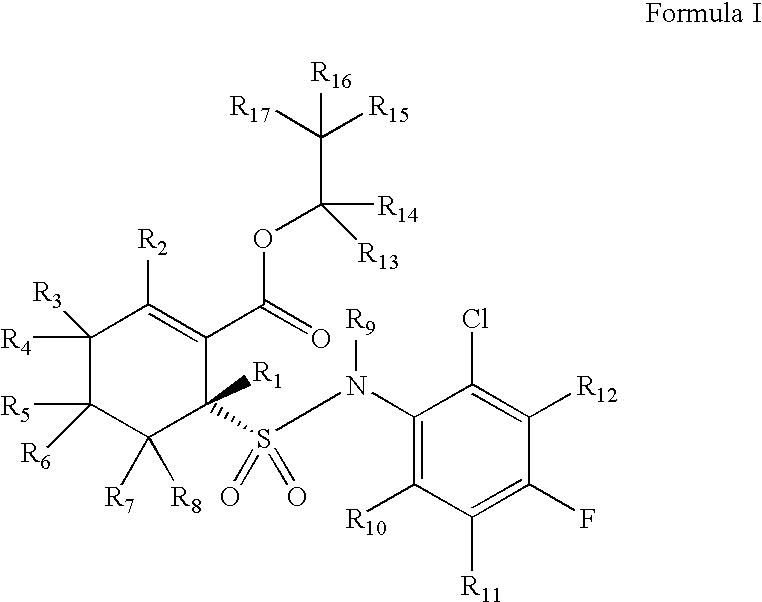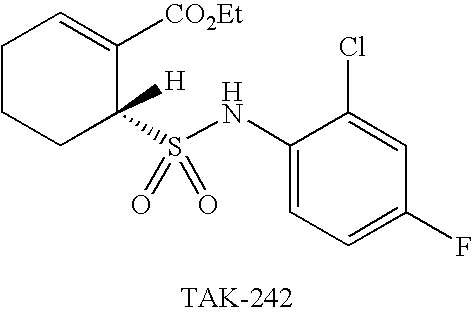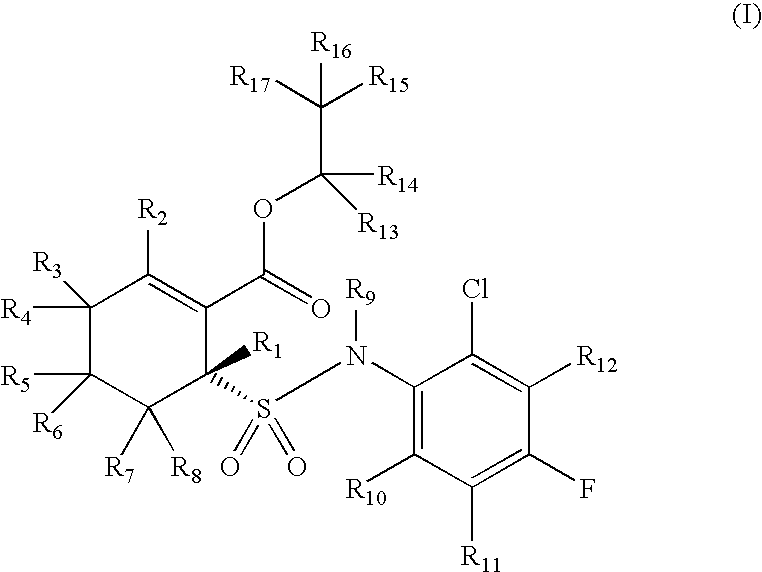Substituted cyclohexenes
a technology of cyclohexenes and substituted cyclohexenes, which is applied in the direction of drug compositions, peptide/protein ingredients, cardiovascular disorders, etc., can solve the problems that other sepsis treatments, like hydrocortisone and drotrecogin- (xigris®), are not as useful as tak-242 and achieve the effect of improving the clinical
- Summary
- Abstract
- Description
- Claims
- Application Information
AI Technical Summary
Benefits of technology
Problems solved by technology
Method used
Image
Examples
example 1
d17-(R)-6-(2-Chloro-4-fluoro-phenylsulfamoyl)-cyclohex-1-enecarboxylic acid ethyl ester
[0278]
[0279]d8-2-Oxo-cyclohexanecarboxylic acid ethyl ester: The procedure of Step 1 is carried out using the methods described in Hellou et al, Synthesis 1984, 1014-1017. A mixture of perdeuterocyclohexanone (prepared as described in Farmer et al, Journal of Medicinal Chemistry 1978, 21(6), 514-520), sodium hydride, and diethyl dicarbonate in toluene are heated at about 80° C. until reaction completion, as monitored by thin layer chromatography. The mixture is quenched with dilute deuterium chloride in deuterium oxide. Following standard extractive workup, the crude product is purified by column chromatography to give the title product.
[0280]d8-2-Mercapto-cyclohex-1-enecarboxylic acid ethyl ester: The procedure of Step 2 is carried out using the methods described in Yamada et al, Journal of Medicinal Chemistry 2005, 48, 7457-7467. At about −50° C., hydrogen sulfide is bubbled through a solution o...
example 2
(R)-Ethyl 6-(N-(2-chloro-4-fluorophenyl)sulfamoyl)cyclohex-1-enecarboxylate and
(S)-Ethyl 6-(N-(2-chloro-4-fluorophenyl)sulfamoyl)cyclohex-1-enecarboxylate
[0288]
[0289]Ethyl 2-mercaptocyclohex-1-enecarboxylate: H2S gas was bubbled through a solution of ethyl 2-oxocyclohexanecarboxylate (20.0 g, 117.5 mmol) in ethanol (200 mL) at −50° C. for 2 hours, then HCl gas was bubbled into the reaction mixture at −20° C. for 2 hours, followed by H2S gas at −20° C. for 2 hours. The reaction mixture was allowed to stand at room temperature for 16 h, then poured into ice cold water (300 mL) and standard extractive workup was performed to afford an oily residue which was purified by distillation to yield the title compound as a reddish oil (12.0 g, 55%). b.p. 136-139° C. / 15-16 mm; 1H NMR (400 MHz, CDCl3) δ 1.30 (t, J=7.2 Hz, 3H), 1.60-1.71 (m, 4H), 2.29-2.39 (m, 2H), 2.43-2.53 (m, 2H), 3.95 (s, 1H), 4.21 (q, J=7.2 Hz, 2H); IR (KBr) ν 2936, 1693, 1593, 1242 cm−1; MS 185 (M−1).
[0290]Ethyl 2-(chlorosul...
example 3
[0294]In vitro Liver Microsomal Stability Assay
[0295]Liver microsomal stability assays are conducted at 1 mg per mL liver microsome protein with an NADPH-generating system in 2% NaHCO3 (2.2 mM NADPH, 25.6 mM glucose 6-phosphate, 6 units per mL glucose 6-phosphate dehydrogenase and 3.3 mM MgCl2). Test compounds are prepared as solutions in 20% acetonitrile-water and added to the assay mixture (final assay concentration 5 microgram per mL) and incubated at 37° C. Final concentration of acetonitrile in the assay should be <1%. Aliquots (50L) are taken out at times 0, 15, 30, 45, and 60 min, and diluted with ice cold acetonitrile (200 μL) to stop the reactions. Samples are centrifuged at 12,000 RPM for 10 min to precipitate proteins. Supernatants are transferred to microcentrifuge tubes and stored for LC / MS / MS analysis of the degradation half-life of the test compounds. It is thus expected that the compounds of formula (I) as disclosed herein will show an increase of 2% to 200% in the d...
PUM
| Property | Measurement | Unit |
|---|---|---|
| Fraction | aaaaa | aaaaa |
| Fraction | aaaaa | aaaaa |
| Fraction | aaaaa | aaaaa |
Abstract
Description
Claims
Application Information
 Login to View More
Login to View More - R&D
- Intellectual Property
- Life Sciences
- Materials
- Tech Scout
- Unparalleled Data Quality
- Higher Quality Content
- 60% Fewer Hallucinations
Browse by: Latest US Patents, China's latest patents, Technical Efficacy Thesaurus, Application Domain, Technology Topic, Popular Technical Reports.
© 2025 PatSnap. All rights reserved.Legal|Privacy policy|Modern Slavery Act Transparency Statement|Sitemap|About US| Contact US: help@patsnap.com



